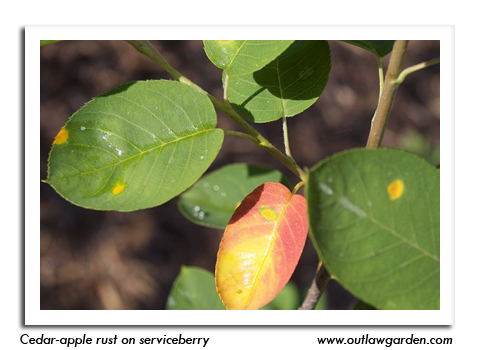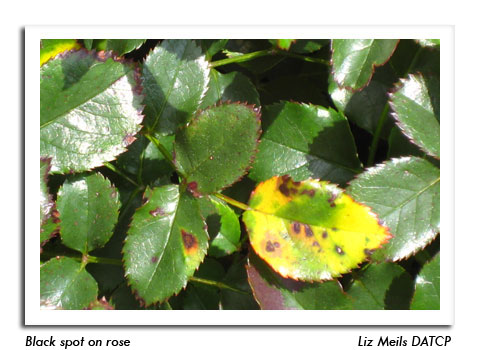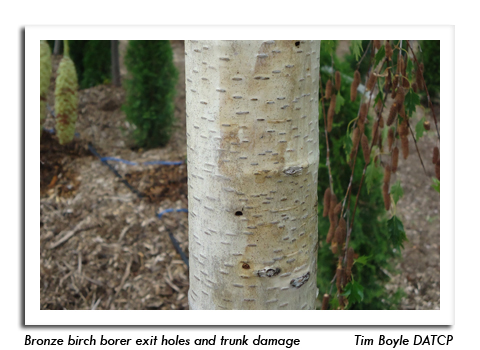
 |
|
|
Nursery & Forest
Volume 59 Number 5 Date 05/29/2014 CEDAR-APPLE RUST - Several 'Autumn Brilliance' serviceberries at a garden center in Eau Claire County were infected with this rust disease, characterized on rosaceous hosts by bright yellow-orange, circular leaf spots. Cedar-apple rust alternates between junipers and rosaceous plants and requires both hosts to complete its life cycle. On juniper, the disease causes the formation of irregularly-shaped brown galls. The bright orange, gelatinous tendrils that emerge from these galls release spores which can infect apples and related fruit trees up to three miles away. Removal of the galls before sporulation is recommended to limit spread of the disease to the alternate hosts: apple, crabapple, hawthorn, quince, pear and serviceberry. BLACK SPOT DISEASE OF ROSE - Symptoms of this common fungal disease were observed on rose 'Sunshine Daydream' at a garden center in southeastern Wisconsin. Diagnostic features are small, round black spots with feathery margins on the leaf surface which enlarge and cause leaves to turn yellow and drop prematurely. The black spots first appear on lower leaves during wet weather as leaves are expanding, but eventually spread to the entire plant. Development of this rose disorder is favored by humid, wet conditions due to rain or overhead watering and can be alleviated by increasing air circulation and removing infected leaves and fallen debris. BRONZE BIRCH BORER - Nursery inspections in Eau Claire County found a severe infestation of this wood-boring beetle in 'Royal Frost' birch trees. Adult bronze birch borers infest trees weakened or stressed due to drought, disease, sun exposure or nutrient deficiency. Larval feeding beneath the bark girdles branches and stems, resulting in thinning or dieback of foliage in the top one-third of the tree canopy. Infested trees also show characteristic swellings or bumps on the trunk around the feeding tunnels, and D-shaped exit holes after the beetles emerge in late spring or early summer. Immediate removal and destruction of infested birch is recommended since this insect kills its host within just a few years. CROWN RUST - The orange-yellow cluster cups which produce spores capable of infecting oats, rye and other grasses are appearing on buckthorn leaves in southern Wisconsin. Heavy amounts of rust inoculum on the buckthorn host may indicate greater rust potential for oats this year if suitable conditions for infection continue. -- Ellen Hermanson, DATCP Nursery Inspector GYPSY MOTH - Aerial spraying for gypsy moth caterpillars started May 22 in Green and Rock counties and continued with treatments as follows: May 23, Lafayette and La Crosse counties; May 27, Richland County; May 28, Grant, Jackson, La Crosse, Lafayette and Richland counties; and May 29, Dunn, Eau Claire and Trempealeau counties. During this first phase of the 2014 spray season, planes are applying Bacillus thuringiensis var. kurstaki or Btk, a biological insecticide acceptable for organic use. Later this summer, select blocks will be treated with a pheromone-based mating disruptor. Larvae are predominantly in the second to third instars in the southern part of the state and first to second instars in the central Wisconsin. Egg hatch has not yet started in the northern tier counties. The annual moth trapping survey is also under way, with 2,899 traps set as of May 28, which is 22% of the estimated total for 2014. Three counties are already complete: Marathon, Waukesha and Wood. Trap setting will continue for the next four weeks, with all traps expected to be in place by the first week of July. According to the WI-MN GMPhen model, adult moths should start emerging in the southern part of the state in mid-July. -- Rick Hummell, DATCP Gypsy Moth Program 




|
|
|